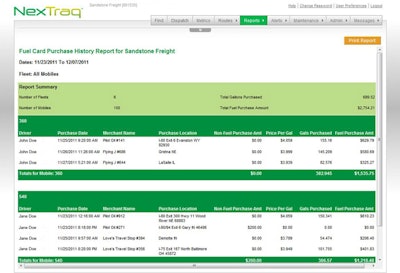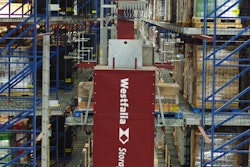
Efficiency and timing are crucial for any company in the food and beverage industry. Managing a facility with product coming in and out can be a difficult task without the proper solution. To help streamline processes and increase productivity, food logistics professionals can utilize technology solutions such as GPS fleet tracking. This technology provides real-time fleet data and simplifies day-to-day tasks, all while helping companies increase revenue and decrease costs.
When transporting food and beverage items, especially perishable goods, it’s important that deliveries are on made on schedule. GPS fleet tracking allows management to monitor truck activity from their computer or mobile device. Fleet managers can view the location of their trucks in real time and see where they have been throughout the day, week or month. Automated alerts can be set up to send instant notification when vehicles enter or exit specified locations. This helps to ensure products are being picked up and dropped off on time.
With multiple trucks making deliveries at various times, an automated job scheduling tool can be extremely beneficial for dispatchers or employees in charge of scheduling. Using a GPS fleet tracking solution, businesses can utilize a drag-and-drop scheduling tool to streamline the process. This allows dispatchers or the appropriate staff to quickly and easily schedule jobs and view all assignments on one screen. This helps to increase productivity and eliminate error that typically comes with paper processes.
Routing also is key in keeping processes running smoothly. Fleet management solutions provide an automated routing feature that takes all stops in a driver’s itinerary, and orders them to create the shortest, most efficient routes to all locations. This is extremely beneficial for drivers who make multiple deliveries in a day. If traffic congestion or road delays pop up, dispatchers can quickly pull up the location of their drivers on the map and re-route them on the fly. Efficient routing not only prevents delays, it gets drivers to locations quicker, so they can get more done throughout the day.
There are many regulations in place regarding the safe transportation of perishable items. To ensure food and beverage safety, certain products must be kept in a refrigerated unit at specific temperatures. Fleet management solutions provide an easy method of monitoring temperatures with the use of temperature sensors. If temperatures move outside of a specified range, fleet managers can receive an immediate alert. Additionally, with temperature reports, management can view a record of temperature readings for any time period selected. This helps to reduce product loss and improve shipment quality.
Because managers can’t be in the field with their drivers at all times, there’s no fool-proof way to validate the time employees spend on the job. After implementing a GPS fleet tracking solution, one leading food and beverage supplier realized that certain drivers were padding their hours. Because the technology acts as a virtual time card, the organization was able to verify hours worked, reducing overtime costs by 50 percent and saving the company more than $80,000 in overhead expenses.
Along with reducing overtime costs, fleet management solutions can help to significantly cut back on fuel spending. Fuel is a major operating cost for any business with vehicles in the field, and with constant fluctuations in price, it can be a difficult expense to manage. Businesses that use fuel cards can take advantage of fuel card integration which allows managers to monitor all aspects of fuel usage. Automated reports provide a detailed view of fuel and maintenance purchase activity, including the purchase location, date and amount spent. This helps to compare usage between trucks and eliminate abuses.
There are also fuel reports that identify wasteful behaviors and pinpoint trucks burning more fuel than they should. Using a fuel slip audit report, managers can identify and mitigate fuel slippage and theft. It points out events in which a purchase was made, but wasn’t made within close proximity of a gas station. This report also shows any purchases that exceed the amount of fuel a truck’s tank can hold. Using automated fuel reports can help businesses better understand driver behavior and improve fuel management.
In addition to lowering fuel spending, implementing a GPS fleet tracking platform can improve driver safety and reduce the risk of vehicle crashes. While it’s important that product is coming in and out on time, safety should always be a top priority. Speeding, aggressive driving and distracted driving not only put truck drivers and other motorists at risk, this behavior can lead to even greater delays and expensive liability claims.
Driver safety reports can be used to identify dangerous behaviors such as speeding, harsh braking, rapid acceleration and sudden cornering. Managers can see which employees practice safe driving habits and which employees are in need of further coaching. Real-time alerts can also be set up to send instant notification when drivers exceed the posted speed limit of a roadway or a user-defined speed limit.
Being able to monitor driver behavior patterns allows businesses to hold drivers accountable and provide further training for those who need it most. As an added bonus, certain auto insurance providers offer discounts of anywhere from 5-15 percent to businesses that utilize GPS fleet tracking technology to improve safety. This allows fleet managers to take advantage of additional savings while protecting their drivers and business.
While many companies have policies regarding cell phone use, it can be difficult to determine if drivers are actually following the rules. Distracted driving is a major concern among commercial fleets. To ensure employees are focused on the road, businesses can utilize a technology that prevents calling, texting, emailing and surfing the web while a vehicle is in motion. Once the vehicle returns to a safe state, all functions are enabled and drivers can use their mobile devices again. Having both a cell phone policy and a distracted driving solution shows employees the importance of safety and promotes responsible driving.
Food and logistics professionals can improve operational efficiency while increasing revenue and decreasing costs using a fleet management solution. Companies that implement the technology can save up to 20 percent in both fuel and labor costs and achieve ROI in as little as one month. With the telematics industry still growing, there will be plenty of future advancements in the functionality and features designed specifically for the food and beverage industry.

















